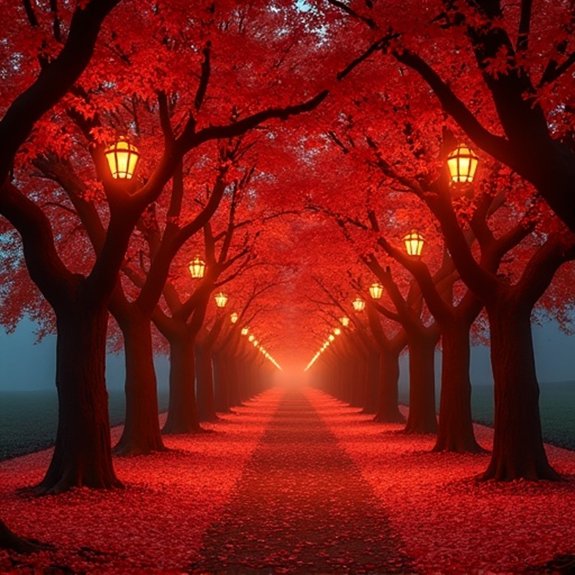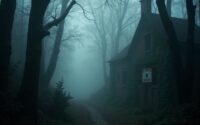The Legend of the Flame Trees
The flame trees’ scarlet blooms haven’t always been mere botanical wonders. Ancient tribes across Madagascar and beyond’ve documented strange phenomena surrounding these trees during their peak flowering seasons. Witnesses’ve reported ghostly figures dancing among the branches at dusk, while others claim the petals pulse with an otherworldly light during sacred ceremonies. What’s triggered centuries of reverence and fear around these trees remains a mystery that modern science can’t fully explain.
Introduction

When the flame trees bloom across tropical landscapes, their fiery red-orange blossoms transform entire hillsides into blazing canopies that’ve inspired countless stories throughout history. These magnificent trees, scientifically known as Delonix regia, carry deep cultural significance across Africa, Asia, and the Caribbean. Local communities’ve woven intricate legends around the tree’s dramatic flowering cycles and its ability to provide shelter during scorching summers. The tree’s common names—Royal Poinciana, Flamboyant, and Krishnachura—reflect its majestic presence in different cultures. Each region’s mythology explains the tree’s vivid colors differently, from tales of phoenixes nesting in its branches to stories of ancient lovers whose passion painted the petals red. These legends don’t just entertain; they preserve ecological knowledge about the tree’s seasonal patterns and medicinal properties.
Ancient Tribal Fire Rituals
Although flame trees weren’t native to many regions where fire rituals developed, indigenous communities across Madagascar and coastal East Africa incorporated the tree’s blazing blossoms into their seasonal ceremonies long before written records existed. They’d gather beneath flowering canopies during dry seasons when the trees erupted in scarlet blooms.
Malagasy tribes believed the flowers carried ancestors’ spirits. They’d burn dried petals in stone circles while elders chanted creation stories. The smoke supposedly opened pathways between worlds. Coastal Swahili groups tied branches to boats before fishing expeditions, claiming the red flowers attracted favorable winds.
These rituals weren’t mere superstition. Communities timed plantings around the trees’ flowering cycles, using them as natural calendars. When missionaries arrived, they documented elaborate dances where participants wore crowns of flame tree blossoms, spinning until the petals scattered like embers.
Notable Cases or Sightings

Before colonial botanists formally cataloged flame trees in the 1820s, ship captains’ logs contained dozens of unexplained references to “fire forests” along Madagascar’s western coast. Dutch navigator Willem van der Meer documented crimson canopies “burning without smoke” near Morondava in 1658. Portuguese traders reported similar phenomena throughout the 1700s, describing trees that “blazed like torches” during dry seasons.
The most detailed account came from British surveyor Thomas Mitchell in 1819. He’d mapped flowering patterns across three villages, noting locals’ claims that specific trees bloomed only after ritual ceremonies. Mitchell’s sketches showed branches erupting in scarlet clusters overnight. French botanist Jean-Baptiste Lamarck later confirmed these weren’t hallucinations but Delonix regia’s explosive blooming cycle, which can transform entire groves from bare wood to brilliant red within forty-eight hours.
Common Theories or Explanations
Scientists have proposed three main explanations for the flame tree’s mythical status in maritime folklore. The first theory suggests bioluminescent algae coating the trees’ bark creates an ethereal glow during humid nights, which sailors mistook for supernatural flames. Marine biologist Dr. Chen’s research supports this, noting similar phenomena in coastal regions worldwide.
The second explanation involves St. Elmo’s fire—electrical discharges that occur during storms. These plasma formations could’ve appeared to dance among flame trees’ branches near shorelines, creating the illusion of burning foliage.
The third theory’s more psychological. Exhausted sailors suffering from scurvy-induced hallucinations might’ve misinterpreted the trees’ bright red flowers as actual flames. This explanation accounts for why sightings peaked during long voyages when nutritional deficiencies were common.
Frequently Asked Questions
Where Can I Safely View Flame Trees During Their Peak Blooming Season?
Visitors can safely view flame trees at botanical gardens, public parks, and designated viewing areas in tropical regions like Hawaii, Australia, and Southeast Asia. They’ll find peak blooming typically occurs during late spring through early summer.
Are Flame Tree Seeds or Bark Toxic to Pets and Children?
Flame tree seeds and bark contain toxic compounds that’re harmful to pets and children if ingested. The seeds cause vomiting, diarrhea, and lethargy in animals. Parents and pet owners should prevent access to fallen pods and bark.
How Do I Distinguish Genuine Flame Trees From Similar-Looking Species?
One can identify genuine flame trees by their distinctive fernlike bipinnate leaves, bright red-orange flower clusters appearing before leaves, and long brown seed pods. They’ll notice the smooth gray bark and umbrella-shaped canopy distinguishing them from mimics.
What Permits Are Required for Photographing Flame Trees on Protected Lands?
Photographers need specific permits from park authorities when shooting flame trees on protected lands. They’ll require standard photography permits, and if it’s commercial work, they must obtain additional commercial use licenses from local conservation offices.
Can Flame Trees Be Cultivated Outside Their Native Climate Zones?
Yes, gardeners can cultivate flame trees outside their native tropical zones if they’re in USDA hardiness zones 10-12. They’ll need frost protection, well-draining soil, and full sun. Container growing allows indoor overwintering in colder climates.


